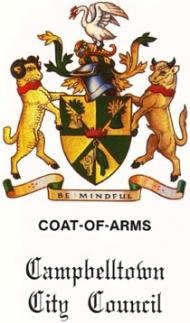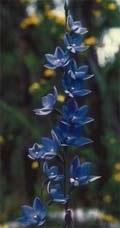The area of Campbelltown was first visited by Governor Hunter in 1795, and was explored by Governor Lachlan Macquarie in the late 18th and early 19th centuries.
On 1 December 1820, Governor Macquarie named the area Campbell Town in honour of his wife’s maiden name, with the area later being known simply as Campbelltown.
In 1882, the area was officially proclaimed as the Municipal District of Campbelltown by the Governor of NSW. Nine Aldermen were elected, with John Ahearn elected the first Mayor of Campbelltown.
The Municipal District of Ingleburn was proclaimed in 1896.
Campbelltown Council built a power station to supply electricity to the area, developed the town’s water supply to cater for the growing population and began work on a sewerage system during the 1920-30s.
During the 1940s, there were moves to amalgamate Campbelltown with other local councils in the area. In 1948, Nepean Shire was abolished and split up.
Campbelltown and Ingleburn were joined into one common council (including part of the Nepean Shire) and became known as the Amalgamated Municipality of Campbelltown.
Cr Kathleen Whitten created history when she was elected as the first female Mayor of Campbelltown in 1961. Despite encountering strong opposition from some of her colleagues, Mayor Whitten proved popular with Campbelltown residents during her one year term. She remained Campbelltown’s only female Mayor until Cr Meg Oates was elected mayor in 1993.
The 1950s and 60s saw rapid expansion in Campbelltown and growth in industry, with a shift away from the town’s rural and agricultural background. Council moved into its current offices in 1964.
The town was proclaimed the City of Campbelltown on 4 May 1968, marking the final stage in its transition from an isolated rural centre to a bustling satellite city. Also on this day, the railway made the switch from steam to electric power.
Campbelltown has continued to grow and develop, from 25,000 residents in 1966, to more than 150,000 today. Campbelltown City Council now employs more than 900 staff.

In August 2019, Council officially endorsed the new city identity for Campbelltown, which was launched with the community on 21 August 2019.
The community of Campbelltown played a vital role in developing the new identity. Community, business owners, elected representatives and Council staff worked together to build on the history of our city and embed a new narrative for Campbelltown and our people - a positive one that represents what we want to be known for, today and in the future.
The new identity for the city captures the positive energy of Campbelltown. It reflects the diverse people and paths that come together to make things happen. It represents that we are a city at the heart of things. A vital and growing city. A city of action. A place where paths and people of the world come together.
Campbelltown has always been a meeting place. It's part of our land and our history. We bring our own stories. We come together to create opportunities and get things done. We are Campbelltown, where opportunity comes to life.

The coat-of-arms was first used for the city in 1969 and holds many elements of the City’s past. It is based on the arms of the Campbell family from Airds, Scotland, after which Campbelltown was named.
Divided into green and gold segments and adorned with sheaths of wheat and fleece, the shield reminds us of Campbelltown’s rural industries, grazing and wheat farming – the first major industry in Campbelltown.
A wall in the shape of a red crown was placed at the centre of the emblem to symbolise civic authority and city status of the council.
Above the shield and set upon the helmet is a wreath in accordance with heraldic law. It incorporates a version of the white swan from the Campbell crest. The fruit, overflowing from the horn, alludes to the produce grown in the Ingleburn region. The red collars of the animals also are an allusion to the then nearby Municipality of Ingleburn. (Ingle - meaning fire, and burn another word for brook..)
The golden horned ram and golden bull, in heraldic terms, are called supporters and are displayed to emphasize the wool and grazing industry heritage of the region brought here by James Ruse and John Macarthur.
In traditional fashion the entire emblem is placed above the Campbell motto scroll “Be mindful”.

The City’s badge is a simplified version of the Coat of Arms and was intended as a clear design which was easy to identify and reproduce.
Used for all of council’s stationery, publications, and signage, the Armorial bearings of the city of Campbelltown was used until July 2001 when it was replaced by the previous corporate logo. The coat of arms is now used as the city’s official seal, on vice regal occasions and for heritage events celebrated in the city.

This version was replaced with the current Campbelltown City identity on 21 August 2019.
This logo version was first used on 1 July 2001.
The green portion represents a leaf, depicting the area’s bushlands.
The blue arch symbolises the water elements, specifically the Georges River, which is a valued natural resource of the area.
The red shape embodies elements of the original Coat of Arms, which was first used in 1969. It is a stylised representation of a crown symbolising the authority of the council. This crown shape also can be seen as the letter ‘c’, the alliterative initial of Campbelltown City Council.
When observed as a whole, the image represents a human element. Like a diver in mid flight, it refers to the sporting nature of the people of Campbelltown, who are regularly in the national and world stage. The emblem may also be viewed as the spirit of Fishers Ghost who, it is said, has haunted the Campbelltown region since 1826. His legend is now celebrated each year in the Fisher’s Ghost Festival held during November.
Colour is an integral part of the design. The three colours chosen – heritage red Green and blue were chosen for their connection with the environment, heritage and local landscape. It was designed with elements of the past in mind and to also reinforce council’s commitment to embracing the changing needs of its community.

On April 29 2004 Council endorsed a Mayoral minute regarding the adoption of a floral emblem for the city of Campbelltown. In September Council decided on a final selection of four candidates for the floral emblem. Three of these were suggested by Council staff in consultation with experts from Mount Annan Botanic Gardens, while the fourth, the Dotted Sun Orchid, was already featured on the logo of Campbelltown’s Heritage Protection Sub-Committee.
These candidates were launched at the spring garden festival on October 12 2004. They were on public display from this time until December 8. Members of the public were encouraged to vote for their preferred floral emblem. After voting ceased it was decided that the Dotted Sun Orchid would be adopted as the City’s floral emblem.
The Dotted Sun Orchid (Thelymitra ixioides) is the most common and wide spread sun orchid in the local area. The species varies from an erect, robust plant 50cm plus in height with numerous flowers, to a much shorter, slender plant with a limited number of smaller flowers.
The flowers are blue or pinkish blue and are usually marked with small dark blue spots on the upper three segments. The lateral lobes of the column extend upward and forward forming two arms ending in white hair tufts. Between these are three shorter, mainly yellow lobes forming a head above the anther.
The Dotted Sun Orchid is common in coastal heath and open forest areas, favouring damp sandy soil. It has a relatively limited flowering period from August to October.